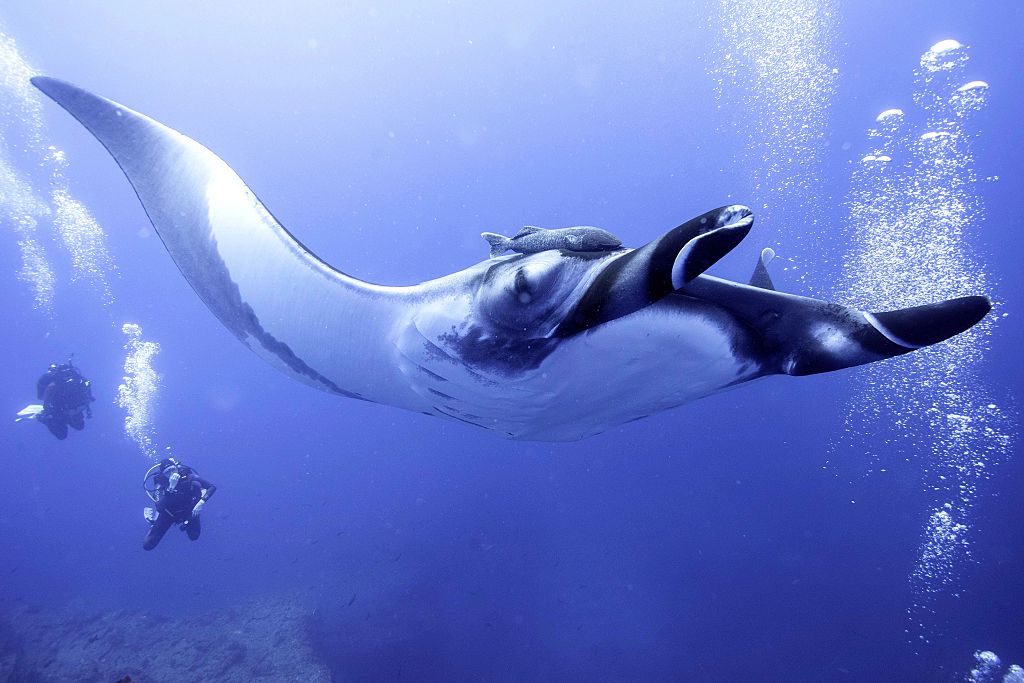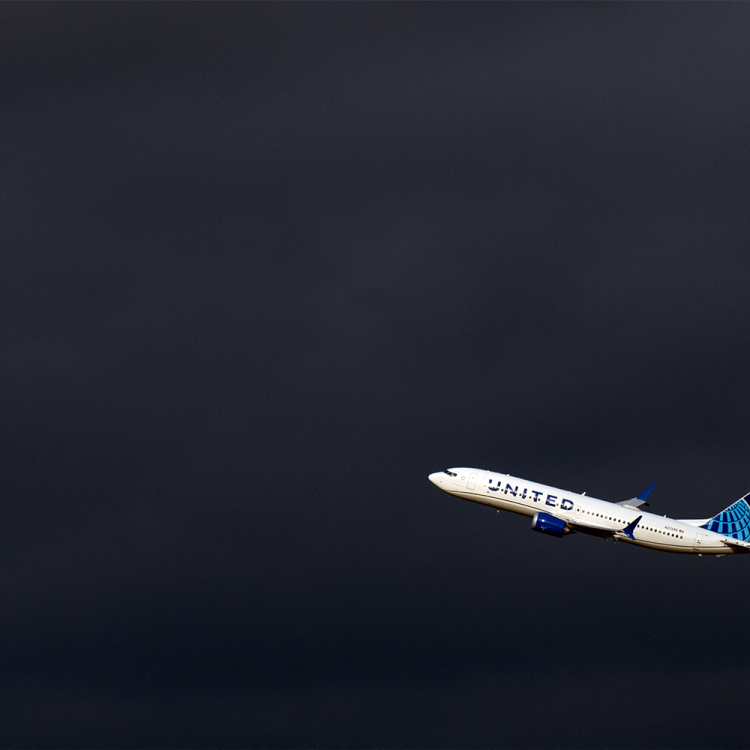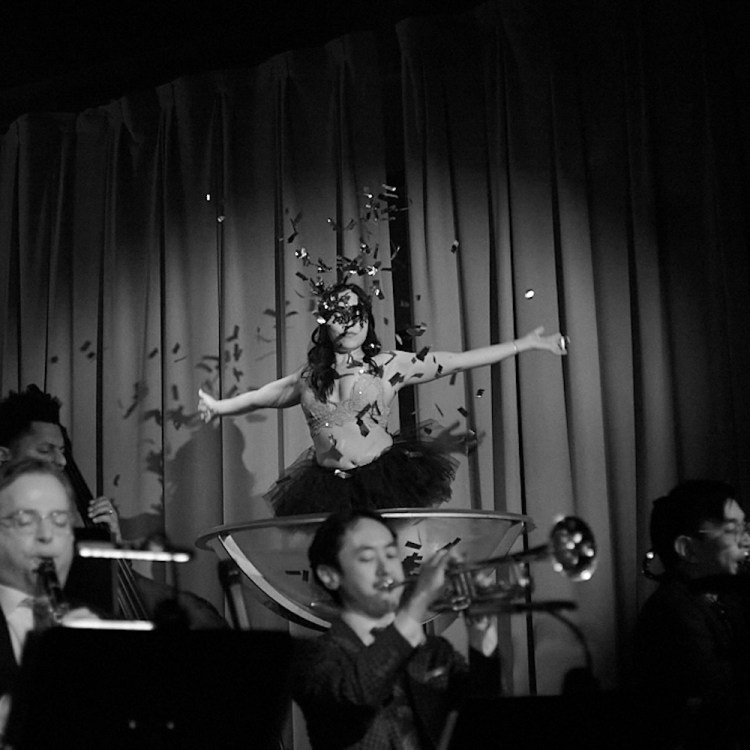When the general population hears the word “sharky,” the common reaction is to stay the hell outta the water or to notoriously look for a bigger boat. On the flip side, when a ship loaded with shark divers, scientists, underwater film makers, adventure journalists and a few dedicated diving enthusiasts hears those same words, they can’t suit up fast enough to get in the water for an encounter with one of the planet’s most magnificent and misunderstood apex predators. Welcome to The Revillagigedo Archipelago … more commonly known as Socorro … a remote string of volcanic islands 250 miles off the coast of Baja California … worlds away from the port of Cabo San Lucas, Baja’s premier tourist hot spot, or as this journalist likes to call it, “Humid Vegas.”
The only way to access Socorro is by live-aboard for a 9-11 day off-grid, wild adventure to what is known in the dive community as one of the best locations on the planet for large pelagic wildlife, crystal clear blue water and an opportunity for magnificent underwater photography. In the scientific community, it’s renowned as a jackpot for studying the migratory behavior of big ocean-going animals like manta rays, whales, and sharks.
Sharky indeed. The area is home to 11 species of sharks. Whale sharks (mostly pregnant females), Galapagos, silky, white tip, black tip, silver tip, tiger, scalloped hammerheads and threshers are the nine species you encounter most often. Humpback whales arrive in winter, December to April, and sometimes orcas make an appearance simultaneously to stalk the calves.
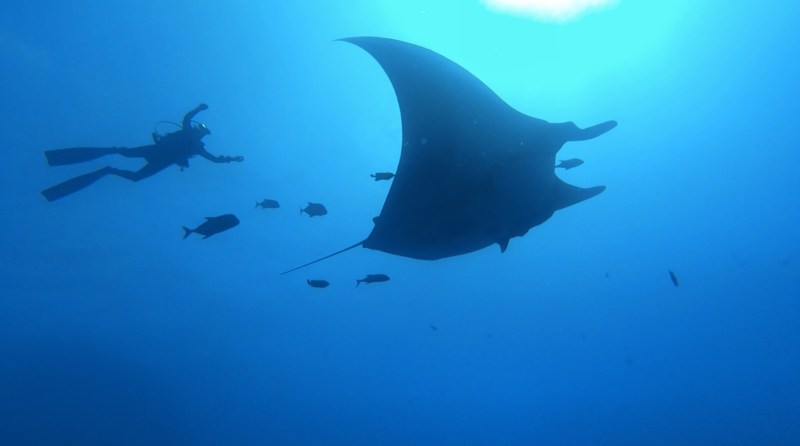
Few dive sites offer the opportunity to, within one sweep of your surroundings through a tempered glass mask, take in a giant Pacific manta ray, tiger shark, school of big-eyed jacks and a pod of dolphins. That’s virtually unheard of … yet here in this most undomesticated corner of the planet … in Mexico’s largest marine sanctuary … it’s the norm. Socorro is a UNESCO World Heritage Site and was upgraded to a marine reserve in 2017. It’s called the Galapagos of North America for its swoon-worthy biodiversity and unmatched access to wildlife.
It’s fair to say that some of our images from the trip look photoshopped. Even an amateur with a Go Pro can capture dive magazine-worthy images of smiling dolphins looking into frame, schooling Galapagos sharks and curious mantas dancing to an unfamiliar soundtrack.
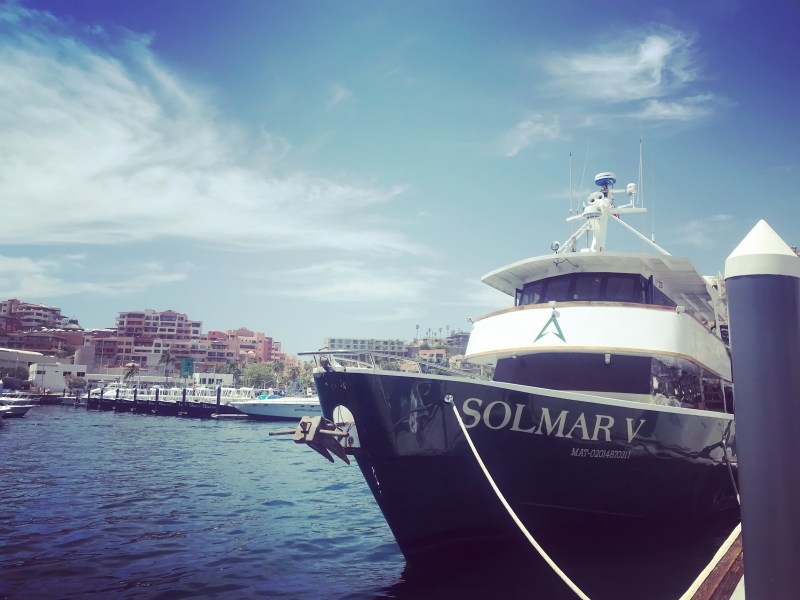
Our boat was the Solmar V, a 112-foot vessel that comfortably accommodates 22 divers, an experienced crew with fantastic dive masters and a definite respect for the eco tourism regulations of the area … all noteworthy points when choosing who to go with. They also make a mean post dive margarita, guacamole I’ll dream about till I return and offer soft pillows and private bathrooms. Important details when your home for nine days is a floating dive hotel. Currently, there are nine live-aboard options for the area … with two more being added over the next year … and not all of them are as delicate with the fragile and still mostly untouched ecosystem. I suspect their guacamole isn’t as good either so choose wisely.
Our first stop after the 24-hour passage was the Island of San Benedicto and a dive site called The Boiler. A marvelous undersea mount that attracts both massive schools of fish and large pelagic species that come in for cleaning and mating. You’d be hard pressed to find an aquarium of equivalent exotic biomass all bunched together like fish soup.
Pods of dolphins curiously approached us, engaged us in spinning games and fired off clicks and whistles, as clearly they had a lot to say to these bubble blowing ungraceful visitors. The giant mantas floated by with such grace and effortless ease that watching them made me sleepy with relaxation. What struck me as most uncanny is that they could have left at any moment, with just a few beats of their massive wings … some spanning over 20 feet … but instead they chose to stay, making lazy circles and letting us swim alongside as they observed our clumsy attempts at mimicking their ballet with eyes the size of billiard balls. It’s a humbling experience to be accepted into the personal space of a wild animal of that caliber. The scientists tagged them, and the mantas shrugged off the three-inch long pin prick with a slight full body shudder and continued to meander around us. Schooling Galapagos sharks, 30 strong, moved around casually as if nothing in the world could be of concern … not even the humans in their midst. Sometimes the school was overhead, backlit by the sun, creating the quintessential image of schooling sharks seen from below. Sometimes the school moved so close that we became part of it. A feeling of wonder and a small shudder of being an outsider in a foreign world would go through my body in these moments. Immense appreciation for these wild corners of the world where nature is king, and we are out numbered, out maneuvered and out bioengineered was the most ubiquitous feeling present in my system. We were fortunate to observe, to participate and to be regarded with such indifference to our presence that it was difficult not to develop as sense of complacency to the environment and wild creatures that surrounded us. Part of the magic of Socorro is its remoteness. Directly behind the sense of wonder is a small voice always reminding us that we are visitors to a marvelous and unforgiving place. This isn’t Disneyland or a pope mobile safari where you watch comfortably from inside a ride. Here you are immersed, folded in as part of the attraction. You recognize your own need for stewardship and responsibility over your personal safety in this place. Although the dive requirements are simple open water certification, with no minimum dives, or free diving if you fancy, you need to know what you’re doing. This isn’t a trip for amateurs. The currents are strong, the depths are considerable, and even though the dive masters will take good care of you regardless, you’ll have more fun if you are comfortable in the water.
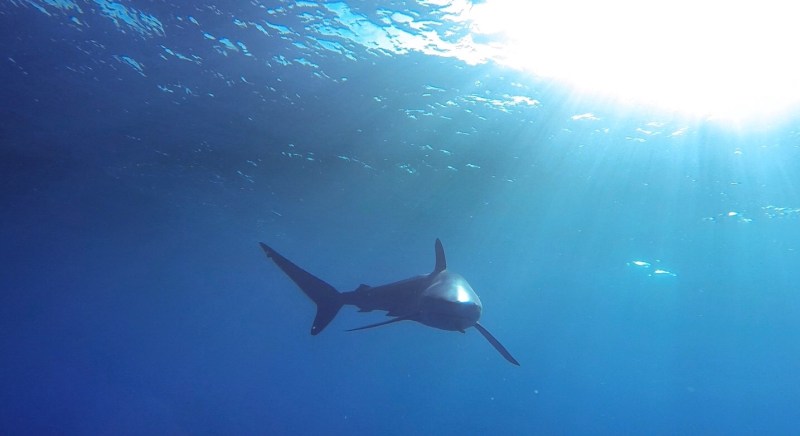
Presence, vigilance, and awareness are heightened by the fact that your small group, 22 strong, is on its own in this blue wilderness. That’s part of the thrill honestly. I asked my dive guide about emergency procedures. He laughed and said, “Don’t do anything stupid. You’re eight hours from an airstrip where planes can only land during the day.” I smiled and rechecked my equipment…again. With that said, the Solmar V’s safety record is impeccable. Partially due to a professional and alert team and partially due to each divers innate sense of self-responsibility…a skill set seemingly lost in the cushioned modern world where airbags and knee pads skew the balance of the natural selection process requiring intelligent choice making skills.
At the start of our dive, a massive whale shark emerged from the blue and made its way to the surface where it cruised past half our team making a safety stop. The area is common for pregnant females and this behemoth looked like she was in the final stages of gestation. Whale sharks give live birth and can have as many as 300 pups…each between 16 and 24 inches long. So, for a visual reference, if you laid those pups nose to tail, they would be as long as the Seattle Space Needle is tall.
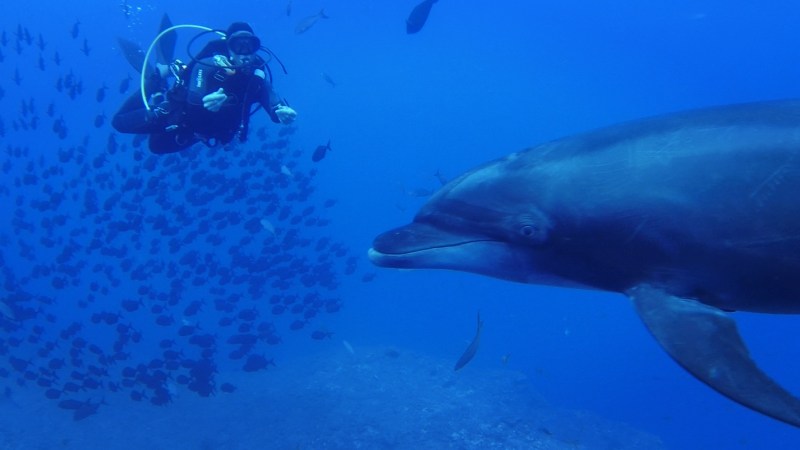
Our safety stops were a hot ticket item for silky sharks, a more curious member of the species, which sometimes needed a gentle reminder to keep their distance. One important note of diving with sharks is to always remember that, although nothing like the blood thirsty killers the media would have us believe they are, they are indeed predators. Eye contact is key. They like to circle behind you to investigate, moving away casually when you turn to face them. Let them know you see them, and for God’s sake don’t go swimming into a bait ball full of feeding sharks for a good shot. That’s the absurd human equivalent of attempting to stand on a moose carcass amongst a pack of hungry wolves. No bueno and a great way to lose a hand.
From San Benedicto we traveled to Socorro and did multiple dives at various locations, exploring the abundant offerings of that particular volcanic island habitat. Mantas, sharks, massive schools of fish, sting rays, yellow tail tuna and plump puffer fish continued to be our daily companions. In between dives we were trained like Pavlov’s dogs to respond to the meal bell and gathered en mass in the galley to feast on Tony the chefs delicious culinary presentations. I’d be hard pressed to boil ramen noodles on a rocking boat yet the seasoned kitchen crew somehow produced everything from BBQ ribs to shrimp and rice in a spicy cream sauce to taco bars complete with fresh salsas and three kinds of meat options. Mango margaritas were the post-dive specialty but if you could dream it, they would mix it. The vegans aboard were treated to the likes of grilled portobello mushrooms and various other vegetable laden creations. No one went hungry or was disappointed at meal time. Quite the opposite really. Although scuba diving technically burns between 300 and 600 calories per hour…the equivalent of a light jog… I’d be surprised if any of us slimed down during our nine days aboard the Solmar V.
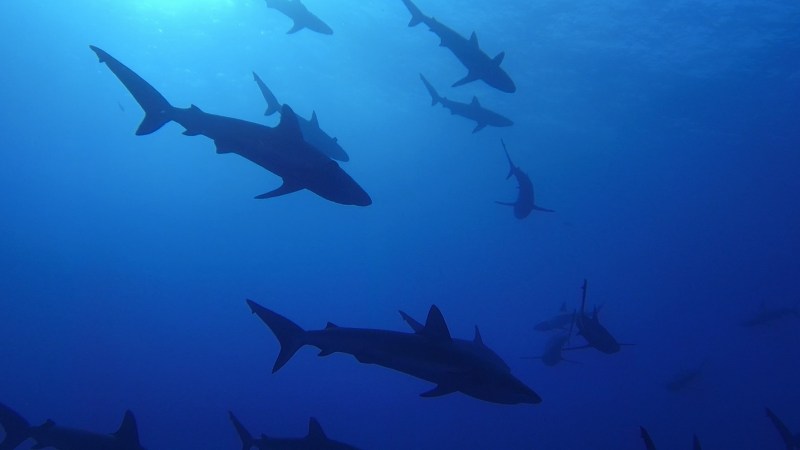
Most spent surface intervals editing footage from the previous dive or taking full advantage of the sun deck to warm up before the next one. In June the water temps are mid 70s but an hour at depth still puts a chill in your core. My five millimeter wetsuit with hood, booties and gloves was perfect.
Our next stop after Socorro was another eight hours away, a lone pinnacle called Roca Partida. It’s majestic split rock formation appeared snow covered from sea bird excrement and waves battered it relentlessly from all sides. A lonely yet beautiful place, not quite land but giving us something solid to set our sea-weary sights upon like castaways eager for a glimpse of anything other than a carpet of expansive cobalt. This site teemed with life like the others and even brought us within sight of the elusive and skittish scalloped hammerheads that are known to school in the area. Out in the blue, just past massive schools of jacks, they materialized out of the cyan depths for a split second before vanishing again into the deep. Their preference is cooler water so depths over 130 feet during the summer and shallower excursions to the surface during winter months.
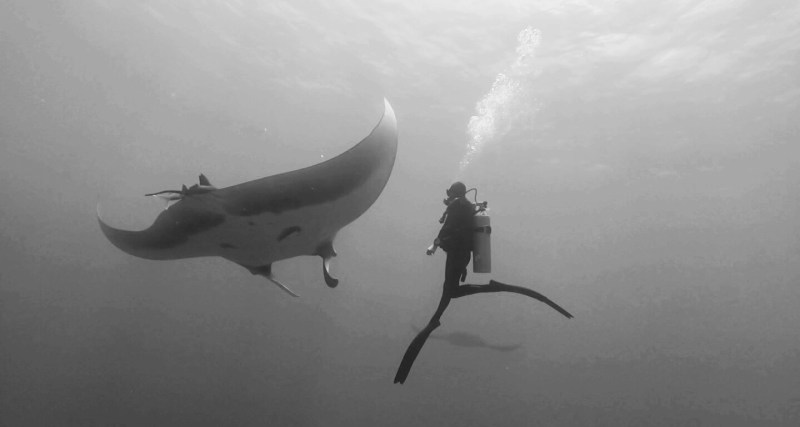
In rock crevices and on any available ledge dozens of white tip reef sharks snuggled together like participants in some drug-induced Burning Man cuddle puddle. Others circled the rock undisturbed by our curiosity except for the occasional side eye glance to make sure their personal space was respected.
There is talk of expanding the protection area, called the tropical eastern pacific corridor, from the Sea of Cortez to Socorro and all the way south to Cocos Island, Malpelo Colombia and the Galapagos to protect the migratory species that travel between these world class undersea destinations. Scientists have already recorded silky sharks making the journey from Cocos to Socorro and a tiger shark that journeyed between Socorro and the Sea of Cortez. This area is home to over 365 species of fish and considered one of the best places in the world to see scalloped hammerheads and giant Pacific manta rays. They come to visit the cleaning stations, the watery equivalent of a day spa, where small fish are afforded an all you can eat buffet of parasites. Chevron and black mantas are the two types most commonly found in these brilliant blue waters. Both look like military stealth bombers with distinguishing patters on their bellies that identify each individual like a human fingerprint. Comically, mantas apparently like air bubbles … on their privates. “Bubble jobs” is what the scientists call it…disproving once and for all that studious types don’t have a sense of humor.
On board our ship was Mauricio Hoyos, one of the world’s foremost shark experts. Well known for his great white shark research on Guadalupe Island, Mexico where he has tagged 105 whites since 2003, he also makes regular appearances on Discovery Channel’s Shark Week and this year you can catch him in two documentaries (Great White Abyss on July 23 at 9pm ET/PT and Great White Babies on July 27 at 10pm ET/PT). Mauricio came to tag sharks in an effort to prove the existence of this migratory corridor…the first step in convincing governments to enact protective measures. Scientists across the Pacific are sharing data to create a map of this underwater highway system working together for the sake of ensuring future generations the same opportunities to be engulfed in schooling sharks.
Another shipmate was Karlos Simon, a foremost expert on tiger sharks and one of two people in the world who have mastered putting these massive fish into tonic immobility…a state of extreme relaxation when placed on their backs. Not for the faint of heart.
The liveaboards also act as unofficial patrols helping to monitor poaching activity. Anything fishy gets reported to the Mexican Navy. They have a small base on Socorro Island and handle conservation enforcement of the region … but appreciates all the extra eyes they can get. The marine reserve is the largest in North America and covers more than 57,000 square miles. Ten years ago the live aboard boats regularly witnessed fishing vessels pulling up sharks. Now it’s rare … and illegal.
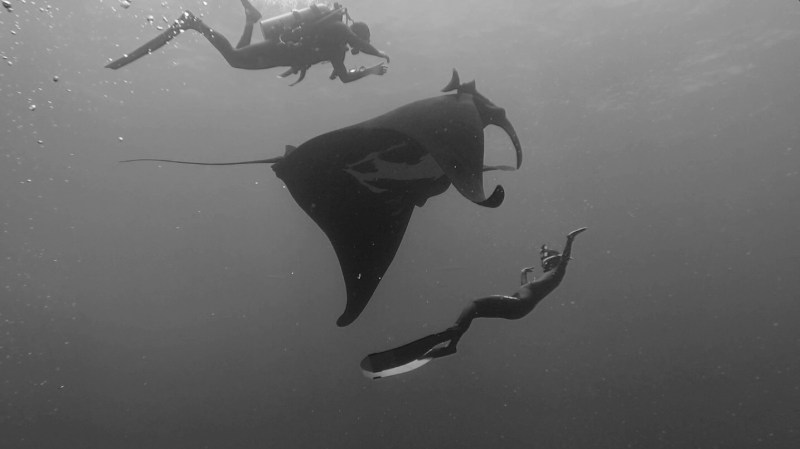
In addition to protecting the marine environment from fishing and exploitation, this new level of protection prohibits any building of hotel facilities on the islands as well as restrictions on mining and other intensive resource development. Slow clap to Mexico for setting the bar on marine conservation.
Adding to the uncanny nature of the overall experience was the regular presence of Alejandro Lemus, a world-class free diver, and part of the research team. His calm appearance at 106 feet to look around the inside of a cave while the rest of us sucked oxygen from tanks on our backs was both surreal and humbling. He was there to tag sharks. Hammerheads were the grand prize but Galapagos and manta rays were equally valuable. His silent movement through the water allowed him even greater access to animal life than us bubble blowing freight trains. A native of the Yucatán Alejandro is a biologist and free diving instructor who has worked with Mauricio for three years. Alejandro’s free diving record is a 341 foot deep, fins only, constant weight trip into the blue that required a four-minute breath hold. To make yourself feel soft read that again. That record might be even deeper now as he was headed to another competition in the Bahamans shortly after our trip. The human body, although not native to the sea, has an incredible penchant for adjusting to her salty, liquid world. I asked Alejandro his secret to free diving. He pointed to his mind and suggested the disciplines of Pranayama … the practice of controlling ones breath … yoga, visualization and meditation.
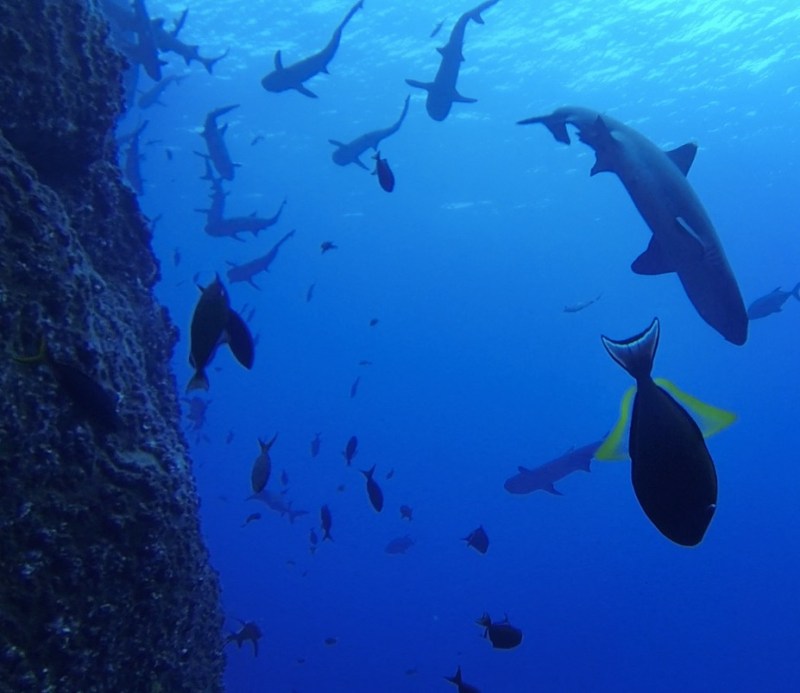
Sunrise on our last day of diving cast a topical orange glow across rocks sprayed with mist from swell. Dorsal fins from curious silky sharks circled our boat, creating an eerie and magnificent spectacle as if we were anchored just off the island containing Jurassic Park … minus the tourists … or the electric fences. Here we were part of the food chain … but certainly not at the top.
Our first dive of the day was murky and cold … a reminder that nature has a mind of her own and we play by her rules. Having been spoiled by countless perfect descents into electric shades of blue and near perfect visibility, we emerged grumbling only to be reminded that nature also has a way of surprising you when you least expect it. Commotion onboard turned into a mass exodus into the pangas as a huge pod of false orcas passed our boat hunting for tuna along the volcanic coast. More rare than orcas this was a treat that only circumstance and timing can offer up. I jumped in with no gear, wrapped in a towel; my swimsuit still wet from the morning dive. For nearly two hours we intersected the whales and jumped in to watch them swim past. They blasted sonar clicks in our direction and examined us briefly with little interest before continuing on their mission. Dolphins, part of the posse, turned on their backs to curiously assess us as they also passed. Dozens of silky and Galapagos sharks followed in full predatory mode hoping for scraps from a kill. Again, reminded that I was not in an amusement park, I turned to find a good-sized silky shark a little too interested in my presence. His behavior was no longer that of lazy circles but more erratic small circles, tighter and tighter around me and lightening fast darts in for an uncomfortably closer look. Feeling exposed and vulnerable I cursed a little underwater as I swatted him away until he lost interest having decided I wasn’t, in fact, a scrap of tuna nor worth the effort. Was he vicious? Nope. Was he hunting? Yes. Was I in the wrong place at the wrong time? Yep. That’s usually how that goes. All toes and fingers fully in tact I headed back to the panga and jumped in again not wanting to miss an opportunity to see the whales. I’ve never seen more fist pumps from divers as I did that day watching our group do nothing short of frolicking with a pod of elusive creatures not many humans have had the opportunity to experience in person.
And here lies the magic of a place like Socorro. There is a long list of natural wonders you are nearly guaranteed to see. Experiences you will have that put you in a small group of humans who have made eye contact while dancing with a giant Pacific manta or schooling alongside hundreds of plate-sized silver jacks. On top of that checklist you have the anticipation of the unexpected. That feeling that anything can happen and you just might be witness to one of nature’s most intimate moments.
The only downside to Socorro is the rude awakening you’ll have as you transition back to reality, from the rhythmic swaying of your boat on the open ocean making its way back to civilization. Entering the port of Cabo San Lucas, watching inebriated tourists dance on poop decks to today’s greatest hits, drives home the surreal nature of our society and the peaceful juxtaposition of the silent world you just left. You feel a bit of an alien observer taking in the mating behaviors of a lesser species with a raised eyebrow at the bizarre nature of it all. Nothing a few margaritas can’t cure I suppose, but what would cure it best of all is turning the Solmar V right back around toward watery paradise.
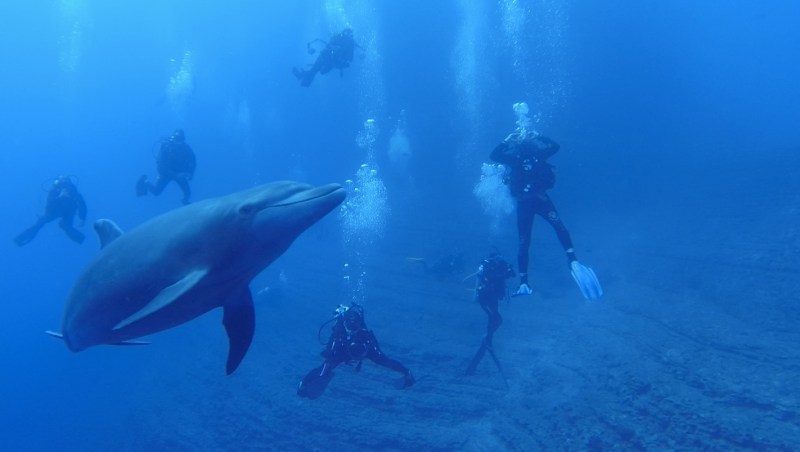
This article was featured in the InsideHook newsletter. Sign up now.
